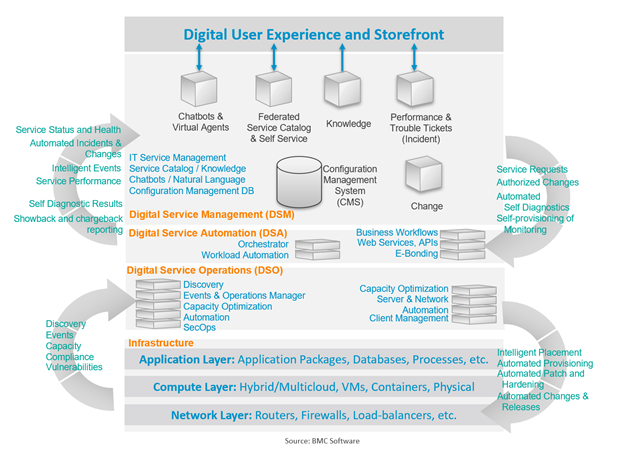Leaders in digital technology like Amazon and Apple are providing consumers with an improved digital experience, both in the services they offer and how they simplify and rationalize the consumer interactions. These experiences are setting consumer expectations for engagement with all companies including IT service providers.
In “6 Benefits of ITIL”, ITIL®1 is defined as “… a set of practices that impart practical and strategic guidance for IT service management, the overall goal of ITIL is to improve the business service.” Implicitly, ITIL focuses on better serving customers in all its process and functions. However, many organizations are so focused on implementation of its processes and functions to achieve reduced costs through improved utilization of resources, that it doesn’t always translate to achieving a strong customer-centric culture.
Technologies such as artificial intelligence (AI) and big data analytics are also set to further disrupt the way consumers interact with companies and IT. Consumers expect service providers to build more meaningful relationships and improve the customer experience through technology and potentially creating a “Zero Touch” way to deliver that service.
These changes in technology and frameworks promise a better consumer experience. In this blog series on ZTSM, I will discuss how these technologies and frameworks, when properly adopted and implemented, can transform your organization into a world-class service provider. Even further, I will describe how giving your customer’s the option of ZTSM will bring your organization more in line with experiences delivered by other industry leaders and are quickly becoming the expectation of modern consumers. This first blog will cover the current state of the customer experience, introduce ZTSM, and describe factors to critical to successfully delivering ZTSM to your customers.
The Current State of the Customer Experience
The current customer experience often falls short of expectations. In their study, “The zero-touch customer experience,” Ericsson reported it typically takes 2.2 attempts over 4.1 days to successfully complete an interaction with service providers. I can personally verify these averages based on a recent experience. When a car hit a telephone pole in my hometown, my 89-year-old mother lost her cable TV service when the resulting power surge blew her two cable boxes. For me, it took 5 days, 3 trips to the local cable store, and a service call just to successfully replace two pieces of technology that promised to be “plug-and-play.”
Ericsson also found that “Forty-six percent of smartphone users think their telecom service provider hides behind ‘bad’ technology, such as do-not-reply emails, automated replies and time-consuming and impersonal ‘Contact Us’ forms.” Only one-third of consumers believe their service provider understands them as a customer. Consumers expect service providers to move beyond chatbots and into intention detection, where issues are handled automatically. More than half (56 percent) of smartphone users expect service providers to anticipate their needs and preempt issues before they occur.
Finally, the above study found, in a zero-touch customer experience, 45 percent of users would use biometric and voice authentication to speed up customer support, and 51 percent would like to see a self-healing network service that detects and solves problems in real time.
The study summarizes that, in a zero-touch customer experience, AI and automation preempt consumer needs and solve issues in the shortest possible time. This change will happen in two ways:
- Enabled by AI, service providers can use data from earlier interactions and consumer behavior to predict what consumers need before they even contact them for support.
- While we have grown accustomed to typing, clicking, and swiping on our devices, new methods are emerging based on voice, gestures, and augmented or virtual reality. In 2017, 1 in 10 households in the US already had a voice-enabled home assistant device such as Amazon Alexa. As voice assistants – and other technology such as biometrics – become more prominent in consumers’ everyday lives, consumers will expect integration of support interactions over those platforms, too.
Zero Touch Service Management (ZTSM)
Providing the zero-touch consumer experience desired by customers requires more than Machine Learning (ML), Artificial Intelligence (AI), and Chatbots. It is more than a Service Desk experience. It starts with a consumer experience in self-service, spans operations where outages are minimized, and leverages available information in every interaction.
By combining industry frameworks such as ITIL with emerging technologies, organizations can achieve a concept I’d like to introduce called Zero Touch Service Management, or ZTSM. This concept merges ITSM Service Desk, IT Operations, orchestration and automation to provide a stable infrastructure supporting services which allow a consumer to choose their communication channels and control their own user-experience.
While ZTSM focuses on automation, within an IT Service Management context, the Service Desk is the sole interface to the customer. Zero Touch Service Management (ZTSM) expands on this premise to encompass the entire service lifecycle from a customer or consumer, point-of-view. This begins with a single, mobile-first, User Interface which includes a Federated Service Catalog with a typical consumer shopping cart experience to request services, access knowledge, view service performance or request assistance with an intuitive omni-channel conversational experience beyond web to include Slackbot, Chatbot, SMS, and Skype. This interface includes workflow and automation to decrease level-one ticket costs by deflecting routine help desk calls. It also includes powerful connectors which easily integrate with leading industry services and platforms like Microsoft Office 365, Microsoft Azure, Atlassian JIRA, Amazon Web Services (AWS), and more.
Orchestration and platform-specific automation then provide zero-touch implementation of requests for new and/or changed services eliminating human error and providing a stable foundation for the service. This includes the proper, intelligent, placement of services within the environment based on real-time conditions, service demands, and resource availability for optimal service quality and resource utilization. As part of this automated provisioning, monitoring and capacity management are established for these new services and supporting devices. Once in production, services are monitored for availability, performance, capacity and security. Any vulnerabilities or standard deviations discovered are automatically remediated through the application of required patches or configuration changes – all while providing a proper audit log and compliance with Incident and Change Management standards. This is an example of self-healing infrastructure. Additionally, the environment is constantly inspected to ensure discovery of manually placed resources as well as current configuration of infrastructure components. All this information regarding discovered devices and configuration, service status, health and performance are passed back allowing context-aware support in the event a user does require manual assistance. The following graphic depicts the flow of information within ZTSM and overlays industry solutions to specific layers of the resulting zero-touch consumer experience.

If I need support for a service to which I subscribe – whether I choose to interact with technology such as a Chatbot or a real person – analysis of all provided information should expedite my interaction. If I subscribe to four services and one is down, it would be safe to suggest that outage as the reason for my call even before speaking to me. By combining awareness of service status, recent changes, past incidents, and known errors in the infrastructure, Service Desk personnel – or Chatbot – should be able to predict the nature of my request for assistance and lead to a prompt resolution to my issue.
Critical Success Factors
While ZTSM can be achieved today with existing frameworks and technologies, it does require some focused effort such as the implementation of governance structures and centers of practice (CoP) for automation which combine both orchestration as well as platform-specific automation technologies into a highly effective practice.
Additionally, for successful adoption of ZTSM, an organization does require some basic technical solution components including the following:
- Integrated, cloud-native, micro-services-based ITSM platform
- Intuitive Self Service with omni-channel conversational experiences
- Single Source of Truth through a Federated CMDB/CMS
- Multi-Cloud Discovery, Orchestration & Automation
- Proactive Closed-loop Security & Compliance
- Open Integrations with other Zero Touch Solutions (e.g., AWS Automation)
If you see the potential of Zero Touch Service Management in providing a foundation for a better experience for consumers of services, then you’ll want to read the remaining blogs in this series. In my next two blogs, I will cover:
- Alignment of ITIL and ITSM to Zero Touch Service Management
- How Service Models and Service Blueprints enable ZTSM
If you are interested in bringing ZTSM to your enterprise, fill out our form and an expert will contact you.
References
1 ITIL® is a Registered Trade Mark of AXELOS Limited. ↩







